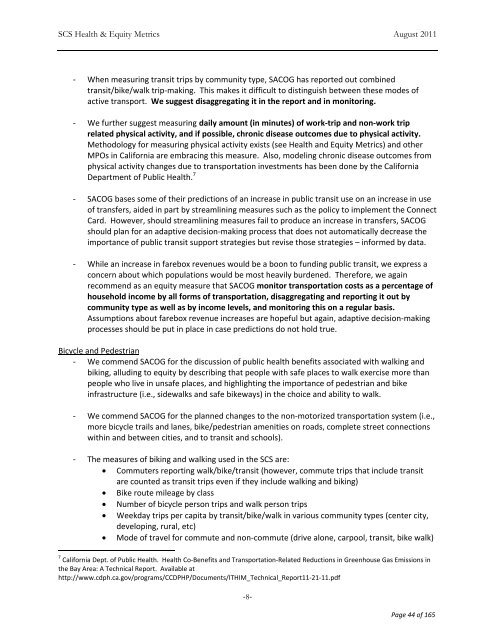Draft MTP/SCS Comments Received - sacog
Draft MTP/SCS Comments Received - sacog
Draft MTP/SCS Comments Received - sacog
You also want an ePaper? Increase the reach of your titles
YUMPU automatically turns print PDFs into web optimized ePapers that Google loves.
<strong>SCS</strong> Health & Equity Metrics August 2011<br />
‐ When measuring transit trips by community type, SACOG has reported out combined<br />
transit/bike/walk trip‐making. This makes it difficult to distinguish between these modes of<br />
active transport. We suggest disaggregating it in the report and in monitoring.<br />
‐ We further suggest measuring daily amount (in minutes) of work‐trip and non‐work trip<br />
related physical activity, and if possible, chronic disease outcomes due to physical activity.<br />
Methodology for measuring physical activity exists (see Health and Equity Metrics) and other<br />
MPOs in California are embracing this measure. Also, modeling chronic disease outcomes from<br />
physical activity changes due to transportation investments has been done by the California<br />
Department of Public Health. 7<br />
‐ SACOG bases some of their predictions of an increase in public transit use on an increase in use<br />
of transfers, aided in part by streamlining measures such as the policy to implement the Connect<br />
Card. However, should streamlining measures fail to produce an increase in transfers, SACOG<br />
should plan for an adaptive decision‐making process that does not automatically decrease the<br />
importance of public transit support strategies but revise those strategies – informed by data.<br />
‐ While an increase in farebox revenues would be a boon to funding public transit, we express a<br />
concern about which populations would be most heavily burdened. Therefore, we again<br />
recommend as an equity measure that SACOG monitor transportation costs as a percentage of<br />
household income by all forms of transportation, disaggregating and reporting it out by<br />
community type as well as by income levels, and monitoring this on a regular basis.<br />
Assumptions about farebox revenue increases are hopeful but again, adaptive decision‐making<br />
processes should be put in place in case predictions do not hold true.<br />
Bicycle and Pedestrian<br />
‐ We commend SACOG for the discussion of public health benefits associated with walking and<br />
biking, alluding to equity by describing that people with safe places to walk exercise more than<br />
people who live in unsafe places, and highlighting the importance of pedestrian and bike<br />
infrastructure (i.e., sidewalks and safe bikeways) in the choice and ability to walk.<br />
‐ We commend SACOG for the planned changes to the non‐motorized transportation system (i.e.,<br />
more bicycle trails and lanes, bike/pedestrian amenities on roads, complete street connections<br />
within and between cities, and to transit and schools).<br />
‐ The measures of biking and walking used in the <strong>SCS</strong> are:<br />
Commuters reporting walk/bike/transit (however, commute trips that include transit<br />
are counted as transit trips even if they include walking and biking)<br />
Bike route mileage by class<br />
Number of bicycle person trips and walk person trips<br />
Weekday trips per capita by transit/bike/walk in various community types (center city,<br />
developing, rural, etc)<br />
Mode of travel for commute and non‐commute (drive alone, carpool, transit, bike walk)<br />
7 California Dept. of Public Health. Health Co‐Benefits and Transportation‐Related Reductions in Greenhouse Gas Emissions in<br />
the Bay Area: A Technical Report. Available at<br />
http://www.cdph.ca.gov/programs/CCDPHP/Documents/ITHIM_Technical_Report11‐21‐11.pdf<br />
‐8‐<br />
Page 44 of 165
















